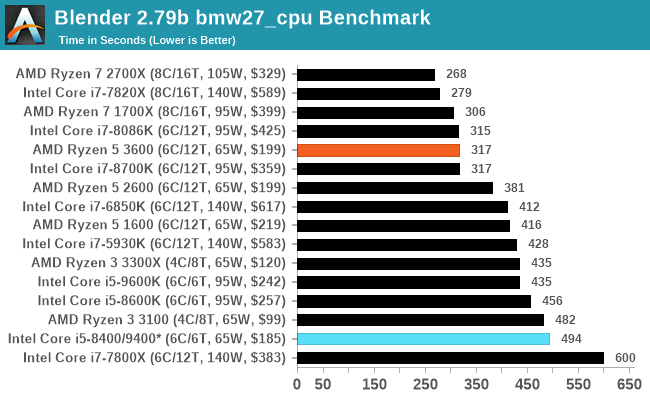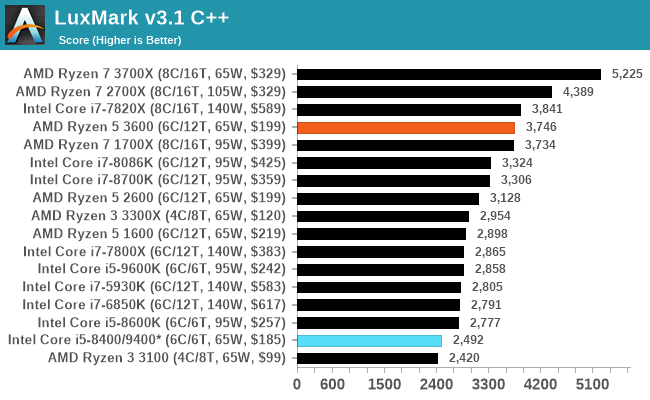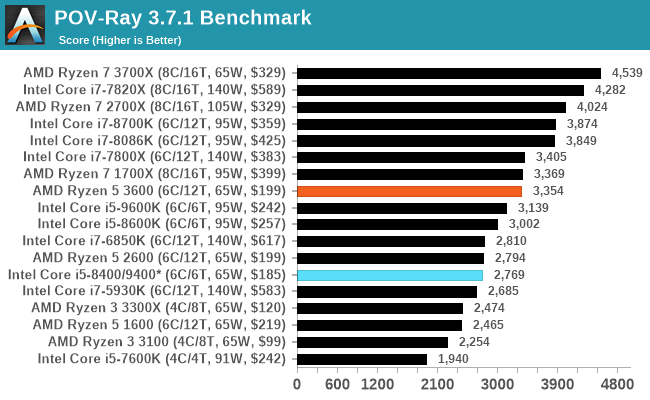AMD Ryzen 5 3600 Review: Why Is This Amazon's Best Selling CPU?
by Dr. Ian Cutress on May 18, 2020 9:00 AM ESTCPU Performance: Rendering Tests
Rendering is often a key target for processor workloads, lending itself to a professional environment. It comes in different formats as well, from 3D rendering through rasterization, such as games, or by ray tracing, and invokes the ability of the software to manage meshes, textures, collisions, aliasing, physics (in animations), and discarding unnecessary work. Most renderers offer CPU code paths, while a few use GPUs and select environments use FPGAs or dedicated ASICs. For big studios however, CPUs are still the hardware of choice.
All of our benchmark results can also be found in our benchmark engine, Bench.
Corona 1.3: Performance Render
An advanced performance based renderer for software such as 3ds Max and Cinema 4D, the Corona benchmark renders a generated scene as a standard under its 1.3 software version. Normally the GUI implementation of the benchmark shows the scene being built, and allows the user to upload the result as a ‘time to complete’.
We got in contact with the developer who gave us a command line version of the benchmark that does a direct output of results. Rather than reporting time, we report the average number of rays per second across six runs, as the performance scaling of a result per unit time is typically visually easier to understand.
The Corona benchmark website can be found at https://corona-renderer.com/benchmark

Blender 2.79b: 3D Creation Suite
A high profile rendering tool, Blender is open-source allowing for massive amounts of configurability, and is used by a number of high-profile animation studios worldwide. The organization recently released a Blender benchmark package, a couple of weeks after we had narrowed our Blender test for our new suite, however their test can take over an hour. For our results, we run one of the sub-tests in that suite through the command line - a standard ‘bmw27’ scene in CPU only mode, and measure the time to complete the render.
Blender can be downloaded at https://www.blender.org/download/

LuxMark v3.1: LuxRender via Different Code Paths
As stated at the top, there are many different ways to process rendering data: CPU, GPU, Accelerator, and others. On top of that, there are many frameworks and APIs in which to program, depending on how the software will be used. LuxMark, a benchmark developed using the LuxRender engine, offers several different scenes and APIs.
In our test, we run the simple ‘Ball’ scene on both the C++ and OpenCL code paths, but in CPU mode. This scene starts with a rough render and slowly improves the quality over two minutes, giving a final result in what is essentially an average ‘kilorays per second’.

POV-Ray 3.7.1: Ray Tracing
The Persistence of Vision ray tracing engine is another well-known benchmarking tool, which was in a state of relative hibernation until AMD released its Zen processors, to which suddenly both Intel and AMD were submitting code to the main branch of the open source project. For our test, we use the built-in benchmark for all-cores, called from the command line.
POV-Ray can be downloaded from http://www.povray.org/












114 Comments
View All Comments
Sonik7x - Monday, May 18, 2020 - link
Would be nice to see 1440p benchmarks across all games, also would be nice to see a comparison against an i7-5930K running which is also a 6c/12T CPUET - Monday, May 18, 2020 - link
Would be even nicer to see newer games. Anandtech reviews seem to be stuck in 2018, both for games and for apps, and that makes them a lot less relevant a read than they could be.Dolda2000 - Monday, May 18, 2020 - link
You exaggerate. The point of a benchmark suite can't really be to contain the specific workload you're going to put on the CPU (since that's extremely unlikely to be the case anyway), but to be representative of typical workloads, and I think the application selection here is quite adequate for that. In comparison, I find it much more important to have more comparison data in the Bench database. There may be a stronger case to be made for games, but I find even that slightly doubtful.MASSAMKULABOX - Saturday, May 23, 2020 - link
Not only that , but slightly older games are much more stable and have most of the performance ironed out. New games are getting patches and downloads all the time, which often affect perfomance. I want to see "E" versions I.e 35/45wThreeDee912 - Monday, May 18, 2020 - link
They already mentioned in the 3300X review they'll be going back and adding in new games like Borderlands 3 and Gears Tactics: https://www.anandtech.com/show/15774/the-amd-ryzen...flyingpants265 - Monday, May 18, 2020 - link
I haven't used AnandTech benchmarks for years. They don't use enough CPUs/GPUs, they never include enough results from the previous generations, which is the most important thing when considering upgrades and $ value.Also, the "bench" tool does not include enough tests or hardware.
jabber - Tuesday, May 19, 2020 - link
Yeah nothing annoys me more than Tech Site benchmarks that only compare the new stuff to hardware than came out 6 months before it. If I see say a new GPU tested I want to see how it compares to my RX480 (that a lot of us will be looking to upgrade this year) than just a 5700XT.johnthacker - Tuesday, May 19, 2020 - link
Eh, nothing annoys me more than Tech Site benchmarks that only compare the new stuff to other new stuff. If I have an existing GPU or CPU and I'm not sure if it's worth it for me to upgrade or stick with what I've got, I want to see how something new compares to my existing hardware so I can know whether it's worth upgrading or whether I might as well wait.Pewzor - Monday, May 18, 2020 - link
I mean Gamer's Nexus uses old games as well.Crazyeyeskillah - Tuesday, May 19, 2020 - link
Just to make this crystal clear, the reason they HAVE to use older games is because all of the PAST data has been run using those games. Most review sites only get sample hardware for a week or less to run the tests then return it in the mail. You literally wouldn't have anything to compare the data to if you only ran tests on the latest and greatest games and benchmarks.When I see people making this complaint I understand that they are new to computers and just want them to understand that there is a reason why benchmarks are limited. Most hardware review sites don't make any money, or if they do, it's enough to pay one or MAYBE two staff members (poorly.) Ad revenue is garbage due to add blockers on all your browsers, and legitimate sites that don't spam blickbaity rumors as news are shutting down. Just look what happened to Hardocp.com, one of the last true honest review sites.
The idea that hardware sites all have stockpiles of every system imaginable and the thousands of hours it would take to constantly setup and run all the new games and benchmarks is pretty comical.